#bikepacking handlebar bag
Explore tagged Tumblr posts
Text
Lone Peak Frame Portage Pack
Whether you're portaging across rugged terrain or preparing for an extended wilderness trip, the Lone Peak Frame Portage Pack is engineered for comfort, durability, and convenience. This meticulously designed pack is perfect for those who need reliable, heavy-duty gear that can handle the toughest challenges.

#chest packs made in the usa#lone peak packs#quality packs made in the usa#bikepacking handlebar bag#across the spiderverse#small handlebar bag#waterproof handlebar bag#biker wallet#handlebar packs#artists on tumblr
0 notes
Text
Summer bike stuff tag sale
Hello, friends! The endless purging of unused items continues. All prices are USD, and do not include shipping. All photos at the bottom of the post. How this works (PLEASE READ!) Domestic shipping will start at $6 USD and go up from there, depending on what and how much you get. We are only selling to US addresses. Local contactless pickup can be arranged (around Mount Tabor in Portland), but…
#big mut#bikepacking bag#Carradice#handlebar#items for sale#kryptonite keeper#portola#randi jo fab#saddlebag#sale#salsa anything cages#shifter#soma#tag sale#treetop goods
0 notes
Text

bikepacking setup
Many people are looking for making an epic adventure with Bikepacking. Cycle Touring Life is the all in one destination for buying the WOHO Bikepacking Setup Bundle. It is a comprehensive bundle for providing everything to setup at an excellent price. These are perfect for begineers as well as experienced bikepackers. Double TPU coated with eco-friendly fabric are enabled for additional strength against wear and tear.
0 notes
Text
i think i have enough to go on a one or two night bikepacking trip alone this summer. i think my dad has an old camping hammock and my mom has a smaller, low profile day hiking backbag. i think i could diy a handlebar bag.
3 notes
·
View notes
Text
Steven Rindner on Choosing the Right Bags for Gravel Bikepacking with Frame, Saddle, and Handlebar Options
Steven Rindner: Find the Best Bags for Gravel Bikepacking

Gravel bikepacking demands gear that’s both functional and accessible, making the choice of bags critical for a successful and enjoyable ride. For goal-driven gravel bikepackers like Steven Rindner, selecting the right storage solutions can significantly enhance comfort, balance, and efficiency on the trails, ensuring essentials are easily within reach without sacrificing stability. With the right bags, riders can tackle varied terrain with confidence and keep focused on the journey rather than their gear. Here’s an overview of frame, saddle, and handlebar bags to help you make the best choice for your adventure.
Frame Bags: Optimizing Space Without Compromising Stability
Frame bags are mounted inside the bike’s main triangle, offering centralized storage that won’t disrupt your balance. They’re ideal for carrying heavier items like tools, food, and even small hydration reservoirs. Frame bags come in various shapes and sizes, allowing riders to select one that maximizes storage while fitting the unique geometry of their bike. Look for bags with sturdy zippers and water-resistant material to keep your gear protected from the elements. For riders who prioritize stable load distribution, frame bags are an excellent option.
Saddle Bags: Lightweight Storage for the Essentials
Mounted behind the seat post, saddle bags are perfect for lighter items like spare clothing, sleeping gear, or snacks. These bags provide extra storage without interfering with steering, making them a solid choice for long-distance rides. Saddle bags come in different capacities; compact ones are ideal for short rides, while larger models can store overnight essentials. Some come with reinforced mounting straps to handle rough trails and prevent swaying. If you’re looking to pack efficiently without adding much bulk, a well-chosen saddle bag can be a game-changer for gravel bikepacking.
Handlebar Bags: Quick Access to Must-Haves
Handlebar bags are the go-to choice for items you may need to access quickly, such as snacks, maps, or a camera. Positioned at the front of the bike, they’re convenient but should be packed carefully to avoid interfering with handling. Handlebar bags come in both compact and roll-top styles, the latter being great for larger loads like a sleeping bag or tent. For gravel bikepacking, lightweight and weather-resistant handlebar bags are ideal, keeping your essentials close at hand while adding minimal weight.
Finding Your Ideal Combination
The best setup often involves a combination of these three bag types. Many riders find that using a frame bag for heavier items, a saddle bag for bulkier gear, and a handlebar bag for quick-access essentials creates a balanced and efficient load. For determined bikepackers like Steven Rindner, selecting the right combination of bags can make the difference between a comfortable ride and a challenging one. Consider your specific needs, the trail length, and anticipated weather to determine the best setup for your journey.
0 notes
Text
Liked on YouTube: I'm Getting Close To The North Cape - Bikepacking Norway
I’m Getting Close To The North Cape – Bikepacking Norway On the 8th day I started seeing the first signs counting down the km to the North Cape. It was really warm for this region, in fact so warm that the reindeer had to take shelter inside of the tunnels from the warmth. My Gear List For My Bikepacking Trip To The North Cape Bike: Kona Sutra (2016) Panniers: Ortlieb Ultimate 6 Handlebar Bag 2 x…
View On WordPress
0 notes
Photo

set of bags for @bibimountain
handlebar bag, mini saddle bag and a matching mini wallet to top it off :)
materials:
xpac vx21 grey xpac vx21 white
fuchsia color accents
#handmade #bag #bagmaking #handlebarbag #saddlebag #burritobag #wallet #custom #bikebag #bikepacking #bikepackinggear #biketouring #roadbike #gravel #gravelriding #sewing #xpac #xpacfabric #vx21 #ykk #diy #vonberg #graz #madeingraz
1 note
·
View note
Text
Are Mountain Bikes Good For Long Distance

Hey there, I'm here to talk about mountain bikes and long distance riding. Whether you're an experienced rider looking for a new challenge or just starting out in the world of biking, this article is for you! Mountain biking has become increasingly popular over the past few years and it's no surprise why - its versatility makes it great for all kinds of terrain. But are they suitable for long-distance rides? In this article, we'll look at how mountain bikes stack up against other bike types when it comes to covering longer distances. So stick around to find out the answer!
The Benefits Of Mountain Biking
Mountain biking is becoming increasingly popular as a form of exercise and recreation, especially for those looking to take up an off-road sport. It's a great way to build skills like balance, agility, strength, and stamina while enjoying the outdoors. The terrain can be challenging but that just makes it more rewarding when you conquer it! One great benefit of mountain biking is the skill building opportunities. You'll learn how to handle turns, steep hills, obstacles like rocks and roots, mud pits and other hazardous surfaces with speed control techniques. With time, your bike handling will become second nature as you gain confidence in your abilities. Plus, this type of riding can help improve coordination since you have to think about what comes next on the trail. Plus, there's nothing quite like taking off on an adventure in the mountains or rolling through peaceful woods or along scenic trails full of wildlife - all from the comfort of your saddle! Mountain biking gives you access to places where few people get to explore and offers breathtaking views along the way. So if you're looking for a fun way to stay active and see some amazing sights then mountain biking could be perfect for you!
The Drawbacks Of Mountain Biking
Mountain biking can be a great way to get exercise and experience the outdoors, but it is not always ideal for long distance rides. For recreational riding, mountain bikes need specialized setup and adjustments that make them less than optimal for extended road trips. The design of modern mountain bikes does not lend itself well to the sustained speed of traditional touring. This means riders must take frequent breaks in order to rest from pedaling uphill or adjust the bike's components as needed. Additionally, most mountain bikes do not offer enough carrying capacity for supplies necessary on longer treks. All these drawbacks mean that while mountain biking is great for short jaunts, it may not provide the best option when undertaking a lengthy journey.
Gear Up For The Long Haul
I'm gearing up for a long haul and I'm wondering if mountain bikes are good for this. Essential gear for a long ride includes a comfortable seat, a reliable helmet, and plenty of water. Maintenance is also important, so I'm making sure to get my bike serviced before I go. Comfort is key, so I'm investing in good quality bike shorts and a handlebar bag for snacks and other items I may need. I'm also making sure to take regular breaks so I can stay comfortable throughout the ride. With all the gear and maintenance I'm doing, I'm confident that a mountain bike will be the perfect companion for my long journey. Essential Gear If you're looking to really get into long-distance mountain biking, then the right gear is essential. Bikepacking, for example, requires that you carry all your supplies and equipment with you on your bike so it's important to make sure you have the right bag systems and racks set up in order to keep everything safe and secure while also balancing weight distribution. Trail etiquette also plays a huge part when it comes to enjoying a successful ride; making sure to show respect to other trail users and taking only what photos or memories from nature without leaving any trace of having been there is key. Knowing how to be prepared before setting out can makes all the difference between an enjoyable experience and one filled with struggles. In conclusion, getting properly geared up for long distance mountain biking isn't just about bringing along essential items - it's also about understanding proper trail etiquette! Maintenance Once you've got the gear and etiquette down, it's time to think about maintenance for your long-distance mountain bike ride. Upgrading components of your bicycle is an important part of making sure that everything runs smoothly - from replacing worn out brakes or buying new tires, these small upgrades can make a big difference in how enjoyable your experience is! Also, don't forget about regular brake maintenance which should be done on a regular basis; after all, having working brakes is essential when biking any distance! It pays off to take the time to get familiar with simple do-it-yourself repairs such as changing inner tubes, fixing flats and lubricating parts like chains; while many people prefer taking their bikes into shops for more complex repair jobs, it's good to know at least some basic techniques so you're not left stranded if something goes wrong during your trip. In addition, carrying spare tools and extra supplies such as pump kits and multi-tools are also great items to have around just in case. At the end of the day, being prepared through proper maintenance before setting out will ensure that your journey remains comfortable and safe throughout its entirety. Comfort When you're gearing up for a long-distance mountain bike ride, it's important to remember that comfort is key. Rider positioning plays an important role in how comfortable your ride will be - making sure the handlebars and seat are adjusted correctly can go a long way towards avoiding pain or fatigue while on the trail. Additionally, having the right tire pressure can also make a huge difference; too much air pressure can lead to uncomfortable riding conditions whereas not enough air pressure may cause frequent flat tires. So take the time to adjust these components beforehand and make sure you have plenty of extra supplies like pumps just in case! With proper preparation, you'll feel more relaxed and prepared for whatever comes your way during your journey.
Preparing For Long-Distance Rides
When it comes to long-distance rides, mountain bikes are an excellent choice. Not only can they handle the rougher terrain you're likely to encounter on your journey, but also certain features of a mountain bike make them ideal for this kind of riding. First and foremost is the importance of getting a proper bike fit before setting off. A good fit helps ensure that you remain comfortable during those long hours in the saddle, so taking the time to get fitted properly will pay dividends down the line. Route planning is another important factor when preparing for a long-distance ride. Knowing where you’re going ahead of time allows you to prepare adequately for any potential challenges along the way, like rough patches or difficult climbs. It also gives you a better idea of how much food and supplies you'll need throughout your trip. You may even want to download maps or purchase printed versions so that you always have access if your phone dies or there's no service available. No matter what route you choose, having the right gear is essential for completing a successful long-distance ride on a mountain bike. With some preparation and due diligence, though, you can be sure to enjoy every minute of your adventure!
Safety Tips For Long-Distance Riding
I'm a big fan of mountain biking for long-distance rides. It's important to keep safety in mind when going on these excursions, however. Here are some tips for keeping yourself safe and having an enjoyable experience. First off, make sure you plan ahead with your nutrition needs before heading out. Hydration is key - bring plenty of water or electrolyte drinks to help prevent heat exhaustion while riding through hot climates. You may also want to bring energy bars or other snacks that will provide sustained energy over the course of your ride. Secondly, be aware of the terrain you'll be traversing during your journey! Be mindful of potential hazards like rocks, roots and bumps along the trail, as well as changes in elevation and weather conditions. Make sure you research what type of bike would best suit the area you're riding in beforehand so you don't find yourself stuck without appropriate equipment mid-ride. Finally, always wear protective gear like a helmet and pads when engaging in any kind of cycling activity - this goes double for longer rides where fatigue can set in more quickly than usual! Also remember to stretch both before and after each session so that your body stays limber and ready for action.
Frequently Asked Questions
What Is The Best Mountain Bike For Long-Distance Riding? When it comes to long-distance riding, the best mountain bike really depends on your body position and gear selection. If you're looking for a comfortable ride that won't leave you feeling sore after hours of pedaling, then consider getting a full suspension model with an adjustable seatpost or handlebars so that you can adjust your positioning as needed throughout the day. On the other hand, if speed is more important than comfort when tackling long distances, then opt for a hardtail mountain bike equipped with wide tires and lower gears so that you can pedal faster without sacrificing too much energy. Whatever type of mountain bike you choose, make sure it's suited to your needs and will provide you with enough support for those longer rides! How Much Should I Spend On A Mountain Bike For Long-Distance Riding? When it comes to selecting the right mountain bike for long-distance riding, there are some factors to consider. Firstly, you should think about how much you want to spend on a mountain bike. It's important not to go too cheap as this could mean sacrificing quality and safety. Generally speaking, expect to invest between $500-1000 depending on your needs. You'll also need to factor in brake maintenance and gear selection - both of which can be costly if done improperly or by an unqualified technician. Ultimately, with careful consideration and research, you should be able to find the perfect mountain bike that meets your budget and requirements for long-distance riding. Should I Use Clipless Pedals When Mountain Biking Long Distances? When it comes to mountain biking long distances, there are a lot of factors you need to consider. One of the most important ones is your pedal type – for instance, clipless pedals can offer improved power transfer and efficiency compared with flat or platform pedals. You also want to make sure that your bike has appropriate gear ratios so that you won’t struggle going up steep inclines on those longer rides. Ultimately, it's up to you decide which pedals work best for your riding style and terrain. How Often Should I Replace The Tires On My Mountain Bike? When it comes to mountain biking, one of the most important aspects is making sure your tires are in tip top shape. Depending on how often you're riding and the type of terrain, tire pressure and gear selection can affect how quickly they wear down. Generally speaking, if you’re a regular rider then you should check your tires regularly for cuts or bulges and replace them every 800-1500 miles, but this could vary depending on where you’re riding. Ultimately, keeping an eye on your tire condition will help ensure that you have a safe and enjoyable ride! Is A Full-Suspension Mountain Bike Necessary For Long-Distance Riding? When it comes to long-distance riding, a full-suspension mountain bike isn't necessarily required. However, there are some advantages to having one such as improved frame geometry and gear ratios that can make your ride smoother and more comfortable over longer distances. Ultimately, the choice of whether or not you need a full suspension bike depends on your personal preference and what type of terrain you'll be riding on.
Conclusion
In conclusion, the best mountain bike for long-distance riding depends on your needs and budget. If you're looking for a reliable ride that won't break the bank, then a hardtail mountain bike is a great option. Clipless pedals are recommended to maximize power transfer from your legs to the bike, while tires should be replaced at least once every two years or when they show signs of wear. A full-suspension bike might offer more comfort than a hardtail over longer distances, but isn't absolutely necessary if you don't mind some bumps along the way. Ultimately, it's up to you to decide what kind of mountain bike will work best for your style of riding and how much money you want to spend. Read the full article
0 notes
Text

Bikepacking handlebar bag review
youtube
0 notes
Photo


Hey friends! Amazon doesn't give you $20 coupons, $0.01 products, and cash back, but Banggood does.Come on!
#bikepacking#handlebar bag#cycling#bicycling#road cycling#Cycling Jerseys#Track cycling#cycling apparel#cycling cap#bicycling magazine#cycling tour#Cycling Club#cycling art#Cycling photography#cycling kit#vintage cycling#womens cycling#cycling life#cycling photo#classic cycling#instacycling#cyclingshots#cyclingstyle#roadcycling#bicycle#bicyclelove#bicyclelife#bicycleportrait#roadbike#bikes
4 notes
·
View notes
Text
Lone Peak Grocery Bag Pannier
The Lone Peak Grocery Bag Pannier is the perfect accessory for cyclists who want to combine practicality with style on their daily commutes, grocery runs, or weekend adventures. This versatile pannier is designed to carry your essentials in a sturdy, compact, and easy-to-use bag that attaches seamlessly to your bike’s rear rack. Whether you're navigating through city streets, cruising on your favorite trail, or heading out to pick up groceries, the Lone Peak Grocery Bag Pannier ensures you’re ready for anything.

#chest packs made in the usa#lone peak packs#quality packs made in the usa#bikepacking handlebar bag#across the spiderverse#small handlebar bag#waterproof handlebar bag#biker wallet#handlebar packs#artists on tumblr
0 notes
Text
Bike Touring and Bikepacking
13 June 2021
I was really happy with my bike and my gear for the ride back from San Francisco. I had considered taking my Surly with the touring gear, but opted instead to take the Warbird and the bikepacking gear. Both would have worked, but I think the latter was simply more enjoyable.
The distinctions between bike touring and bikepacking are nuanced, debated, semantic, and sort of irrelevant, but to me touring implies riding long distances over many days on the road, whereas bike packing suggests more an off-road bicycle equivalent to backpacking. But the line between these two pursuits is blurry. In addition, bike touring and bikepacking are associated with different types of bikes and different ways of carrying gear - a touring bike with paneers versus a mountain bike with soft luggage. But again, the lines are fuzzy.
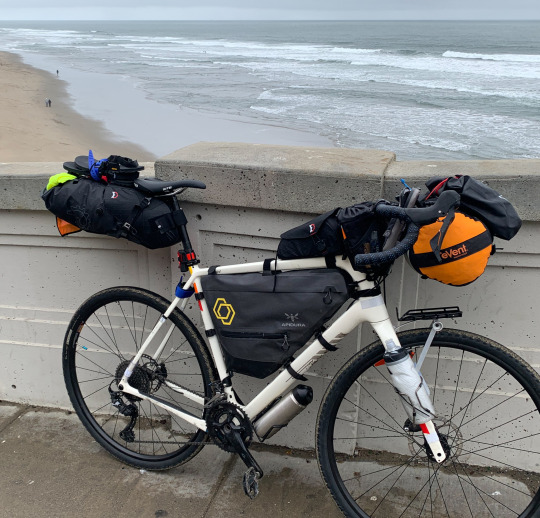
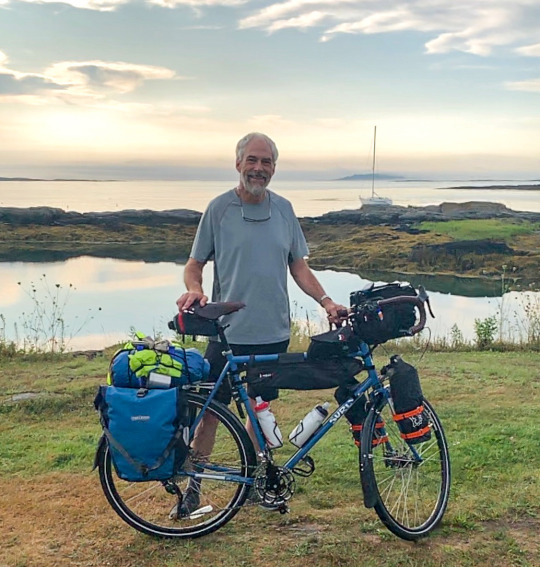
My 2019 cross-country trip was pretty classic touring. My Surly Disc Trucker is a classic touring bike and I was loaded with panniers, duffels, and a handlebar bag. But during the past year and a half, my Salsa Warbird has become my go-to bike for both day rides and 3-4 day overnight trips. It’s a lot more fun to ride than the Surly. It’s lighter, it handles better, and frankly, I really like indexed shifting at my fingertips. The Salsa is very much a gravel bike with wider tires and is comfortable on both pavement and on rough gravel roads. On the other hand, the bike requires a completely different approach to packing.
One of the things that makes the gravel bike/bikepacking setup work is that you can’t carry as much stuff, so it’s lighter (it helps that the bike itself is much lighter, too). This not only makes pedaling uphill easier, it makes it easier to maneuver the bike around obstacles or carry it up steps. Combine this with the way the weight is distributed - higher and narrower - and the fact that the bike itself handles more nimbly than a touring bike, and the result is a much more fun and versatile touring rig.
BIKE
The bike is a Salsa Warbird with a 61cm carbon frame. It has Shimano GRX components with 2x11 gearing. It came with an 11-34 rear cassette, which I've swapped out for an 11-40. This gives me a much-needed granny gear for steep, loaded climbs. I had to tighten up a loose derailleur hanger early in the trip, but besides that the only problem was noisy gears as the grit and the crud built up on the chain, the pulley wheels, and the chain guides. Occasional attempts to clean things helped, but it was hard on the road to do a very thorough job.
TIRES
The tires are 700x42s. The front tire is the Teravail Cannonball that came with the bike (4000+ miles), still with the same tube. The rear tire is a relatively new Teravail Washburn set up tubeless. They both worked well - no flats and and few signs of wear over the 1200-mile trip. I topped off the air a couple of times (larger tires means I run fairly low pressure - maybe 45psi).
ATTACHMENTS
A Wahoo Bolt bike computer (and a cadence sensor on the crank). A rear blinker. I had a good headlight, but kept it stowed the entire trip, since there were no night rides and no tunnels. I have bottle cages on my forks and under the down tube. A Salsa Cradle is mounted to the handlebars, to which I strap my sleeping gear. I have an improvised porteur rack above the front wheel (the carbon forks are not intended to carry a traditional front rack) that provides some extra stowage for light stuff and a mounting location for the headlight. All the other luggage is soft stuff strapped to the frame.
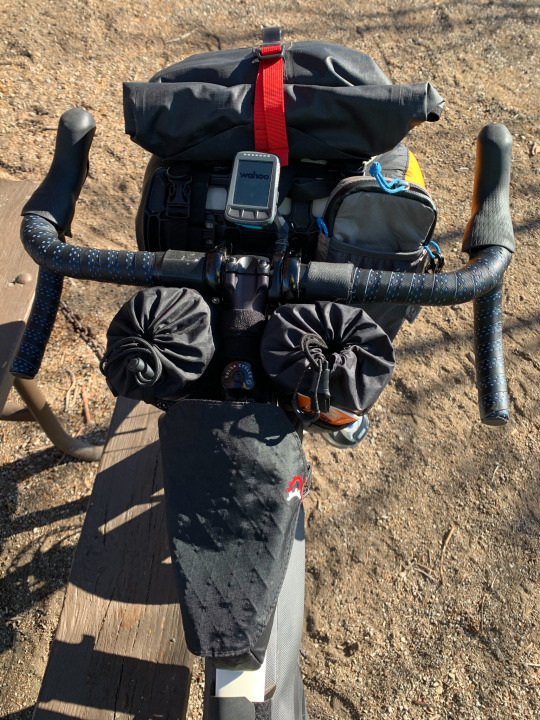

LUGGAGE
Handlebar roll. A good compression dry sack holds my 'sleeping system.' It straps into a cradle on the bars.
Utility bag. Easy to unclip and bring with me when I'm away from the bike. Holds electronics, toiletries, spork and knife, other odds and ends. An additional pouch served as a holster for my iPhone.
Two stem/feed bags. Easy access to snacks, layers, and a little spare space for a bottle of Gatorade, a defrosting burrito, or in one case, a chocolate milk shake.
Gas tank/top tube bag. Small camera, handkerchief, buff, face mask.
Seat bag. Clothing, outerwear (when not strapped on elsewhere), a small cook set, a little food. I strap on a pair of sandals which serve as camp shoes, town shoes, and for potential water crossings.
Frame bag. Tools, spare tube, parts and supplies, water filter, stove, tent poles/pegs, a small daypack, a small towel, and so forth. It’s a good place to stuff frozen burritos, extra napkins, sweaty arm warmers, and other stuff during the day.
GEAR
It’s impressive how much stuff I squeezed into a pretty compact suite of luggage. This photo shows everything I took off the bike when I got home, including the clothes off my back, the helmet and glasses off my head, and the shoes off my feet.
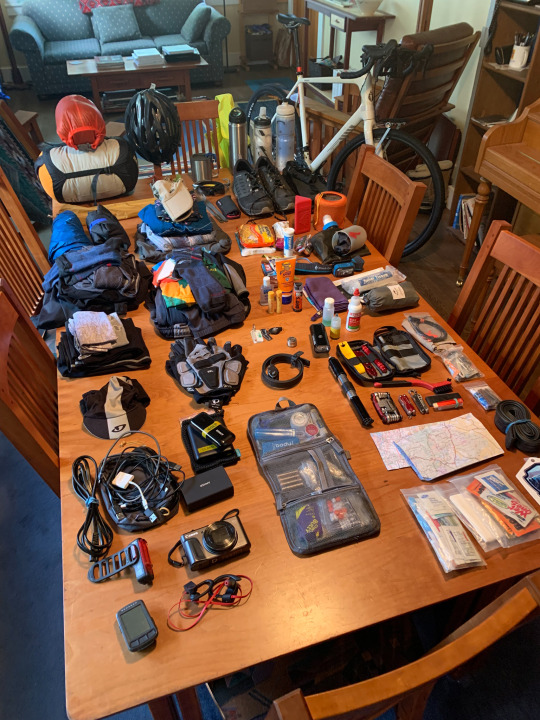
Shelter/Sleeping. My ‘sleeping system’ fits in a small dry bag on the handlebars. It includes a lightweight tent, a down quilt, and an ultralight air mattress. The combination works to the mid-30s and if it’s colder, I can wear my down jacket. The tent poles and pegs live in the frame bag.
Clothing. A change of bike shorts and socks, a short and long sleeve jersey. A set of lightweight clothes for off the bike. A rain jacket, rain pants, and a light down jacket. I’ve got both fingerless and full-finger gloves. Two headbands, one for sweat, the other for warmth. Arm warmers. Leg warmers. A rain cap. A baseball cap. When I'm on roads and not wearing my rain gear, I usually wear a lightweight yellow vest - both for visibility and as a windbreak.
Cooking. I have an MSR pocket rocket stove in my frame bag and a compact cook set in my seat bag (small titanium pot, fuel canister, lighter, rubber scraper, and a stove stand). I don’t cook much, but mornings are better with boiling water for coffee and oatmeal. I occasionally cook a dinner, such as a dehydrated backpacking meal.

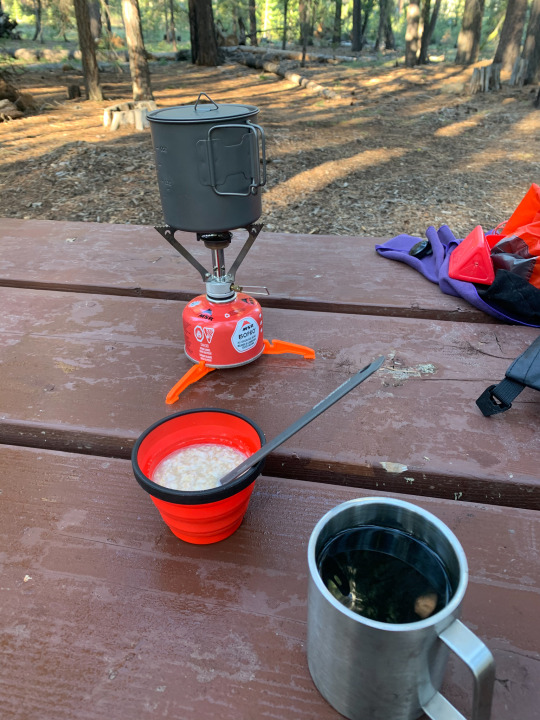
Food. Unlike backpacking, where you carry food for days or weeks, biking involves resupplying as you go. When expecting to camp, I tend to buy a sandwich or packaged burrito earlier the day, though I always have some sort of backup meal in my gear. I carry instant oatmeal packs and instant coffee for mornings. I keep an assortment of snacks - nuts, string cheese, pepperoni sticks, candy bars, gels, energy bars, fig newtons. Things that cover a range of cravings and nutritional needs and that can be easily restocked at gas stations and general stores.
Drinks. I carried three water bottles, one on each side of the fork and another under the down tube. Whether I use all of them depends on conditions and availability of water. I can typically make room in a stem bag for more water or a large bottle of Gatorade when I expect a long dry stretch. I have a small collapsible water bag and a water filter so I can resupply from natural water sources.
Tools and supplies. The lower portion of the frame pack holds bike tools, supplies (Gorilla tape, super glue, a patch kit), and spare parts (brake pads, chain link, zip ties). An extra tube, a small pump, tire sealant, and a small bottle of chain lube. I keep my good bike multitool and a small knife/scissors in a pocket on one of my stem bags for easy access.


Electronics. iPhone. Bike computer. Rear blinker. Headlight (not used). Canon SX720 camera (small camera with a good zoom). All USB rechargeable. A good 13mAh battery (I can go three days on phone, blinker, and bike computer with this). And a spare 6mAh battery, just in case. A corded five-outlet USB charger/adapter. An SD-lightning adapter to load camera pics to phone. And several microUSB cables and a lightning cable for phone (this can fail and is critical, so a spare makes sense). Cables and charger live in a pouch in the utility bag. It didn’t happen on this trip, but on long days I can charge phone and bike computer while I’m riding.
Other Stuff: First aid kit, TP, a small fast-dry towel, shower wipes (wish I’d discovered these years ago). Wallet (in jersey or shirt pocket), a bunch of quarters for showers and car washes. A few paper maps for old times sake and souvenir stickers I pick up along the way. The mesh pockets on the stem bags hold a bike multitool, a small knife/scissors, a small bottle of DEET, hand sanitizer, and sunscreen. I have two sticks of Burt’s Bee’s Wax - one is for chapped lips and the other is for my pedals to keep my cleats/shoes from squeaking (I try to keep the two straight). It’s nice to have this stuff easily accessible and not buried deep in larger bags.
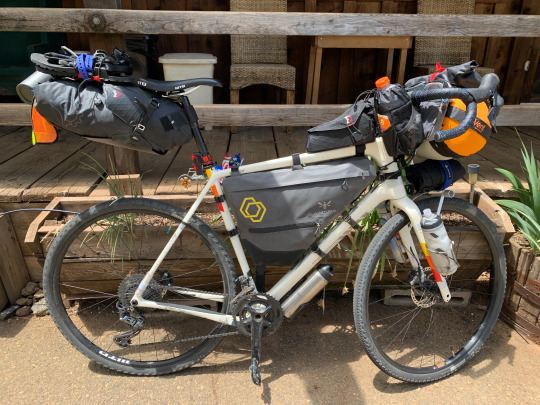
5 notes
·
View notes
Text

bikepacking setup
Many people are looking for making an epic adventure with Bikepacking. Cycle Touring Life is the all in one destination for buying the WOHO Bikepacking Setup Bundle. It is a comprehensive bundle for providing everything to setup at an excellent price. These are perfect for begineers as well as experienced bikepackers. Double TPU coated with eco-friendly fabric are enabled for additional strength against wear and tear.
0 notes
Photo

// BEYOND 1 voted among "Best Touring Bikes 2021" at @cyclist_mag (UK) // "A radical and very modern touring bike, the Bombtrack Beyond 1 is ready to venture far from the beaten track. Mountain bike width tyres, massively broad gearing and great flared handlebars mean it excels when the going gets rough. With a low slung frame, it's easy to chuck around. This is paired with a high front end to reduce stress on arms and back when spending hours in the saddle. With mudguard, rack and three bottle mounts, it'll take traditional panniers or bikepacking bags. There are even fixings to directly attach a snack box to the top tube." (by Cyclist UK) #bombtrackbeyondone21 #bombtrack #bombtrackbicycleco #bikepacking #ontheroad #adventure #bikepacker #travelbike #worldbybike #cycletouring #bikewander #adventurecycling #adventureisoutthere #biketouring #wanderlust #outsideisfree #bombtrackgroundwork #steelisreal #bombtrackusa https://www.instagram.com/p/CO-fBW9lHVo/?igshid=2uxegfzpdc7w
#bombtrackbeyondone21#bombtrack#bombtrackbicycleco#bikepacking#ontheroad#adventure#bikepacker#travelbike#worldbybike#cycletouring#bikewander#adventurecycling#adventureisoutthere#biketouring#wanderlust#outsideisfree#bombtrackgroundwork#steelisreal#bombtrackusa
2 notes
·
View notes
Photo

Reposted from @outsideandseek - Get to ride this beauty for a few days. Have always wanted to try out @laufcycling. I never pretend to be a pro reviewer of bicycles but I do feel more in control on gravel, especially on the chunkier terrain where normally from time to time I would lose a hand due to a big bump. I definitely feel less micro jitters on the hands which led to more long term comfort. - Also stoked to ride with @postcarryco’s new handlebar bag. I have never tried the circular form and dig it thus far. Perfect for my 85mm lens, some tools and snacks. - #adventurecycling #cycling #bikepacking #eastonadventure #laufcycling #postcarryco #groad #groadslikethese @johnsonstudios.co #hizokucycles HizokuCycles.com https://www.instagram.com/p/B5toIiTHURJ/?igshid=i3gi794fjn1y
#adventurecycling#cycling#bikepacking#eastonadventure#laufcycling#postcarryco#groad#groadslikethese#hizokucycles
32 notes
·
View notes
Photo

(via EVOC gives bikepacking bags a twist with Boa Fit System for handlebars & seat posts - Bikerumor)
26 notes
·
View notes